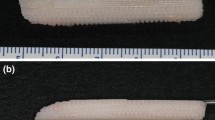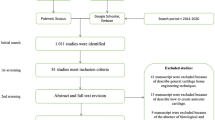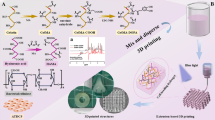Abstract
This study is a part of ongoing research conducted to develop an ideal implant for augmentation rhinoplasty using a combination of cartilage tissue engineering and 3D printing (3DP) techniques. A promising nasal implant-shaped (NIS) scaffold for rhinoplasty should have flexibility similar enough to native cartilage tissue to maintain its mechanical stability after implantation into a nose. In scaffold fabrication using 3DP, the pore pattern or architecture has a significant effect on the mechanical properties of a scaffold. In this study, we proposed octahedron pore architecture inspired by a zigzag spring, which stores more mechanical energy than a simple rod. Therefore, we assumed that the scaffold having octahedron pore architecture is more flexible than one that has the cube or lattice pore architecture that is widely used in tissue engineering based on 3DP. To verify this assumption, scaffolds having octahedron, cube, or lattice pore architecture with the same porosity and same unit cell size were fabricated using projection-based micro-stereolithography and sacrificial molding, and their mechanical behaviors were analyzed using compression and three-point bending tests. Compared to the other pore types, the octahedron pore architecture had superior flexibility, which is beneficial for clinical application of NIS scaffolds.
Similar content being viewed by others
References
Vuyk, H. D. and Adamson, P. A., “Biomaterials in Rhinoplasty,” Clinical Otolaryngology, Vol. 23, No.3, pp. 209–217, 1998.
Lin, G. and Lawson, W., “Complications using Grafts and Implants in Rhinoplasty,” Operative Techniques in Otolaryngology-Head and Neck Surgery, Vol. 18, No. 4, pp. 315–323, 2007.
Hutmacher, D. W., Schantz, T., Zein, I., Ng, K. W., Teoh, S. H., and Tan, K. C., “Mechanical Properties and Cell Cultural Response of Polycaprolactone Scaffolds Designed and Fabricated Via Fused Deposition Modeling,” Journal of Biomedical Materials Research, Vol. 55, No. 2, pp. 203–216, 2001.
Zein, I., Hutmacher, D. W., Tan, K. C., and Teoh, S. H., “Fused Deposition Modeling of Novel Scaffold Architectures for Tissue Engineering Applications,” Biomaterials, Vol. 23, No. 4, pp. 1169–1185, 2002.
Tham, C., Lai, Y. L., Weng, C. J., and Chen, Y. R., “Silicone Augmentation Rhinoplasty in an Oriental Population,” Annals of Plastic Surgery, Vol. 54, No. 1, pp. 1–5, 2005.
Seol, Y. J., Kang, T. Y., and Cho, D. W., “Solid Freeform Fabrication Technology Applied to Tissue Engineering with Various Biomaterials,” Soft Matter, Vol. 8, No. 6, pp. 1730–1735, 2012.
Sohn, Y. S., Jung, J. W., Kim, J. Y., and Cho, D. W., “Investigation of Bi-Pore Scaffold based on the Cell Behaviors on 3D Scaffold Patterns,” Tissue Engineering and Regenerative Medicine, Vol. 8, No. 4, pp. 66–72, 2011.
Ciocca, L., De Crescenzio, F., Fantini, M., and Scotti, R., “CAD/CAM and Rapid Prototyped Scaffold Construction for Bone Regenerative Medicine and Surgical Transfer of Virtual Planning: A Pilot Study,” Computerized Medical Imaging and Graphics, Vol. 33, No. 1, pp. 58–62, 2009.
Huey, D. J., Hu, J. C., and Athanasiou, K. A., “Unlike Bone, Cartilage Regeneration Remains Elusive,” Science, Vol. 338, No. 6109, pp. 917–921, 2012.
Xia, W., Liu, W., Cui, L., Liu, Y., Zhong, W., et al., “Tissue Engineering of Cartilage with the Use of ChitosanGelatin Complex Scaffolds,” Journal of Biomedical Materials Research Part B: Applied Biomaterials, Vol. 71, No. 2, pp. 373–380, 2004.
Wang, Y., Ameer, G. A., Sheppard, B. J., and Langer, R., “A Tough Biodegradable Elastomer,” Nature Biotechnology, Vol. 20, No. 6, pp. 602–606, 2002.
Jung, Y., Park, M. S., Lee, J. W., Kim, Y. H., Kim, S. H., and Kim, S. H., “Cartilage Regeneration with Highly-Elastic Three-Dimensional Scaffolds Prepared from Biodegradable Poly (L-Lactide-Co—Caprolactone),” Biomaterials, Vol. 29, No. 35, pp. 4630–4636, 2008.
Lee, J. S., Cha, H. D., Shim, J. H., Jung, J. W., Kim, J. Y., and Cho, D. W., “Effect of Pore Architecture and Stacking Direction on Mechanical Properties of Solid Freeform Fabricationbased Scaffold for Bone Tissue Engineering,” Journal of Biomedical Materials Research Part A, Vol. 100, No. 7, pp. 1846–1853, 2012.
Kang, H. W., Park, J. H., Kang, T. Y., Seol, Y. J., and Cho, D. W., “Unit Cell-based Computer-Aided Manufacturing System for Tissue Engineering,” Biofabrication, Vol. 4, No. 1, Paper No. 015005, 2012.
Yoo, D. J., “Porous Scaffold Design using the Distance Field and Triply Periodic Minimal Surface Models,” Biomaterials, Vol. 32, No. 31, pp. 7741–7754, 2011.
Sun, W., Starly, B., Nam, J., and Darling, A., “Bio-CAD Modeling and Its Applications in Computer-Aided Tissue Engineering,” Computer-Aided Design, Vol. 37, No. 11, pp. 1097–1114, 2005.
Komatsubara, M., Namazu, T., Nagasawa, H., Tsurui, T., and Inoue, S., “Cylindrical Film Deposition System for Three-Dimensional Titanium-Nickel Shape Memory Alloy Microstructure,” Vacuum, Vol. 83, No. 3, pp. 703–707, 2008.
Tawney, G. L., “Zigzag and Helical Springs; Elastic Properties of Molybdenum,” Review of Scientific Instruments, Vol. 10, No. 5, pp. 152–159, 1939.
Jung, J. W., Kang, H. W., Kang, T. Y., Park, J. H., Park, J., and Cho, D.-W., “Projection Image-Generation Algorithm for Fabrication of a Complex Structure using Projection-based Microstereolithography,” Int. J. Precis. Eng. Manuf., Vol. 13, No. 3, pp. 445–449, 2012.
Liska, R., Schwager, F., Maier, C., CanoVives, R., and Stampfl, J., “WaterSoluble Photopolymers for Rapid Prototyping of Cellular Materials,” Journal of Applied Polymer Science, Vol. 97, No. 6, pp. 2286–2298, 2005.
Kang, H. W. and Cho, D. W., “Development of an Indirect Stereolithography Technology for Scaffold Fabrication with a Wide Range of Biomaterial Selectivity,” Tissue Engineering Part C: Methods, Vol. 18, No. 9, pp. 719–729, 2012.
Kang, H. W., Seol, Y. J., and Cho, D. W., “Development of an Indirect Solid Freeform Fabrication Process based on Microstereolithography for 3D Porous Scaffolds,” Journal of Micromechanics and Microengineering, Vol. 19, No. 1, Paper No. 015011, 2009.
Pan, Y., Zhao, X., Zhou, C., and Chen, Y., “Smooth Surface Fabrication in Mask Projection based Stereolithography,” Journal of Manufacturing Processes, Vol. 14, No. 4, pp. 460–470, 2012.
Atala, A. and Mooney, D. J., “Synthetic Biodegradable Polymer Scaffolds,” Springer, pp. 1–12, 1997.
Neuendorf, R. E., Saiz, E., Tomsia, A. P., and Ritchie, R. O., “Adhesion between Biodegradable Polymers and Hydroxyapatite: Relevance to Synthetic Bone-like Materials and Tissue Engineering Scaffolds,” Acta Biomaterialia, Vol. 4, No. 5, pp. 1288–1296, 2008.
Lutz, J. F. and Hoth, A., “Preparation of Ideal Peg Analogues with a Tunable Thermosensitivity by Controlled Radical Copolymerization of 2-(2-Methoxyethoxy) Ethyl Methacrylate and Oligo (ethylene glycol) Methacrylate,” Macromolecules, Vol. 39, No. 2, pp. 893–896, 2006.
Nguyen, T. Q. and Kausch, H. H., “Molecular Weight Distribution and Mechanical Properties,” Mechanical Properties and Testing of Polymers, Vol. 3, pp. 143–150, 1999.
Melchels, F. P., Bertoldi, K., Gabbrielli, R., Velders, A. H., Feijen, J., and Grijpma, D. W., “Mathematically Defined Tissue Engineering Scaffold Architectures Prepared by Stereolithography,” Biomaterials, Vol. 31, No. 27, pp. 6909–6916, 2010.
Author information
Authors and Affiliations
Corresponding author
Rights and permissions
About this article
Cite this article
Jung, J.W., Park, J.H., Hong, J.M. et al. Octahedron pore architecture to enhance flexibility of nasal implant-shaped scaffold for rhinoplasty. Int. J. Precis. Eng. Manuf. 15, 2611–2616 (2014). https://doi.org/10.1007/s12541-014-0634-0
Received:
Revised:
Accepted:
Published:
Issue Date:
DOI: https://doi.org/10.1007/s12541-014-0634-0




